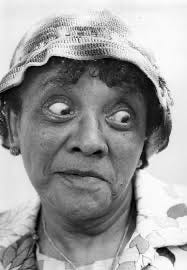Moms Mabley, in Vaudeville and On Stage
After a difficult childhood, this comedic icon got her start in vaudeville and the stage before TV helped make her a mainstream star.
It has been suggested that Moms Mabley might have been the first successful stand-up comic. Her heyday was the vaudeville era. She achieved her fame by playing in front of live audiences. She also performed in theater.
With television, Mabley was rediscovered. Even today, her memory has been kept alive.
Moms Mabley’s tragic childhood
The former Loretta Mary Aiken was born in 1894 in North Carolina. Both her parents died during her adolescence. Before the age of sixteen she had borne at least two children, the result of rape.
She gave them up for adoption. Then her stepfather coerced her into marriage to an older man she didn’t like.
Small wonder she ran away from home. She went to Cleveland, hitching a ride with a traveling minstrel show.
The “chitlin circuit” of vaudeville
At the dawn of the twentieth century, vaudeville was the popular live entertainment of the day, a venue for singers, dancers, comedians, tragedians, and more.
Black entertainers, restricted by Jim Crow laws and other forms of prejudice, reached their audiences through their own version of vaudeville known as the “chitlin circuit.” (“Chitlin,” short for chitterling, is a soul food staple.)
Whereas white vaudevillians played in fancy theaters, the CC operated out of nightclubs and juke joints and similar venues closer to the black audiences’ experience. Many great black entertainers of the twentieth century worked the circuit or knew people who did.
Young Loretta Aiken took to this environment. Assuming the stage name Jackie Mabley, in payback for an ex-boyfriend who mistreated her, she developed a comedic repertoire of her own.
Mabley mentored under a comedy team known as Butterbeans and Susie. In time, they encouraged her to move to New York.
New York and the Apollo Theater
In New York, Mabley debuted at a club called Connie’s Inn in Harlem. She continued working the CC throughout the twenties and thirties.
She adopted the image of an irreverent (and horny) old woman, in a house dress and floppy hat. It gave her license to speak about race, sex and politics. She called herself “Moms,” in tribute to her grandmother. This persona served her well in later years, when the civil rights movement grew in strength.
She also cross-dressed, appearing in men’s suits for Christmas cards. Friends knew about her fluid sexuality, but no one cared. Her nickname was “Mr. Moms.”
In 1939, she became the first female comic to play the Apollo Theater. Opened in 1914, it began as a burlesque theater but admitted black patrons in the twenties due to Harlem’s growing black population. Mabley joined other black entertainers to the venue such as singer Bessie Smith and comic Pigmeat Markem.
Mabley participated in theater. She co-wrote a play with Zora Neale Hurston. Mabley appeared in a play called Blackberries of 1932 with Mantan Moreland and later, an update of A Midsummer Night’s Dream called Swingin’ the Dream, with Louis Armstrong, Dorothy Dandridge and Butterfly McQueen, among others. (It bombed despite the talented lineup.)
Mabley also had roles in films and recorded comedy albums, including the 1956 A Night at the Apollo, with liner notes by Langston Hughes.
Mabley’s rediscovery
With the emergence of television, Mabley found a new audience, appearing in various variety shows. She played Carnegie Hall, recorded a Top 40 song, and headlined a major movie.
Mabley died in 1975. In the eighties, as part of her one-woman stage show, Whoopi Goldberg portrayed her. Later, in 2013, Goldberg directed a documentary about her.
Recently, Wanda Sykes played Mabley in the Amazon Studios series The Marvelous Mrs. Maisel.
Many comedians, black and white, have acknowledged the debt they owe to Mabley as a trailblazer.
@byrichwatson
—————
Do you know someone who saw Moms Mabley?



